A flower is a fragile blossom with petals and grows at the top of the stem of a plant. Flowers attract bees, who help with pollination so more plants can grow. In their range of color, size, form, and anatomical arrangement, flowers present a seemingly endless variety of combinations.
Unfortunately, these flower crops are susceptible to various pests and diseases. Below are some commonly affecting pests and diseases and their control methods to prevent your flower crops from infections. To cultivate flower crops, you should know how to identify symptoms and their treatment.
How to control pests and diseases in flower crops
Diseases in flowers
Powdery mildew
Plants in the flower garden are commonly affected by powdery mildew. Powdery mildew looks like fine, soft powder sprinkled on your plants. Unfortunately, this common fungus can spread from leaves to stems and even to buds. Moreover, it can and will spread to other nearby plants. Bushes with fresh new foliage are its favorite snack, and their presence can damage the leaves.
Hosts: Zinnias, Snapdragons, Verbena, Delphiniums, Lungwort, Bee Balm, Garden Phlox, Aster, Centaurea, Coreopsis, Lathyrus, Monarda, and Rudbeckia.
In case you missed it: Earning 24 Lakh Rupees from Polyhouse Chrysanthemum Cultivation: A Success Story of a Flower Farmer in India
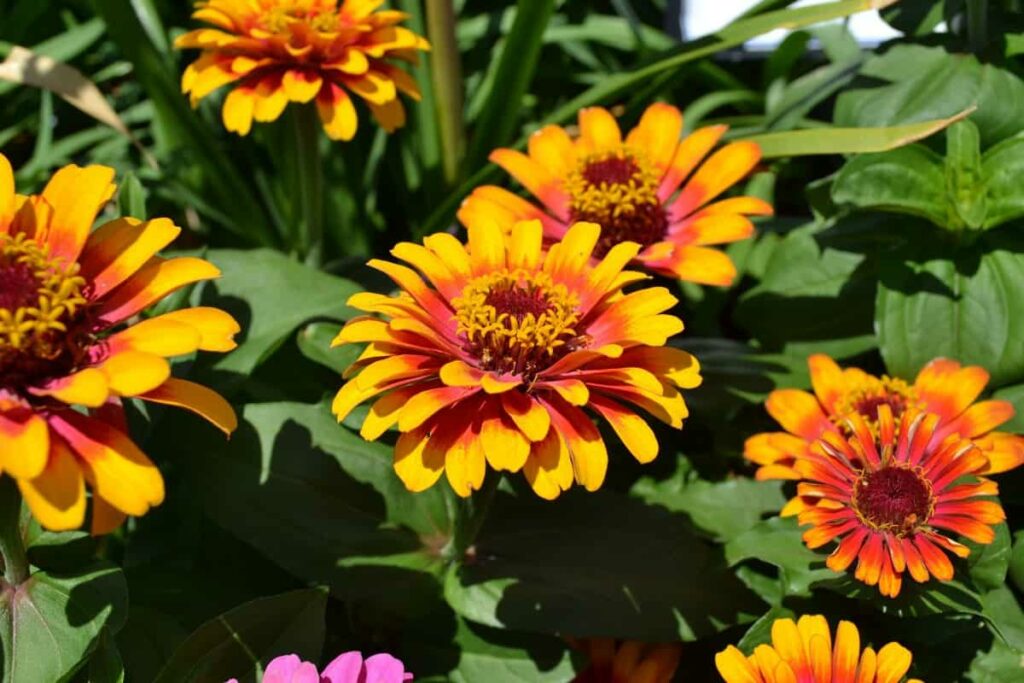
Disease symptoms
- Powdery mildew can easily be diagnosed with white, powdery patches on the leaves and stem’s upper surface.
- Greyish-white powdery growth appears on the leaf, sheath, stem, and floral parts.
- Powdery growth later becomes a black lesion and causes the drying of leaves and other parts.
- When severe, the disease may reduce plant growth and flowering.
Chemical control and management
- Wash foliage occasionally to disrupt the daily spore-releasing cycle. Neem oil used on a 7-day schedule will prevent a fungal attack on plants grown indoors
- Apply sulfur or copper-based fungicides to prevent infection of susceptible plants. For best results, apply early or at the first sign of disease. Spray all plant parts thoroughly and repeat at 7-10 day intervals up to the day of harvest.
- Many different fungicides protect plants against powdery mildew if applied correctly. Low-impact fungicides like sulfur, potassium bicarbonate, and horticultural oils are recommended.
Anthracnose
During any stage of plant growth, anthracnose can attack all plant parts. Therefore, this disease can go through multiple infection cycles throughout the growing season. Stems, leaves, and fruit of infected plants develop dark, water-soaked lesions. During moist, warm weather, the centers of these lesions often become covered with pink, gelatinous spores. On seeds, soil, and garden debris, the fungal disease overwinters. Cool and wet weather promotes its growth. Insects, wind, rain, and garden tools contribute to its spread.
In case you missed it: 11 Potting Soil Mixes for Flowering Plants: Top and Best List
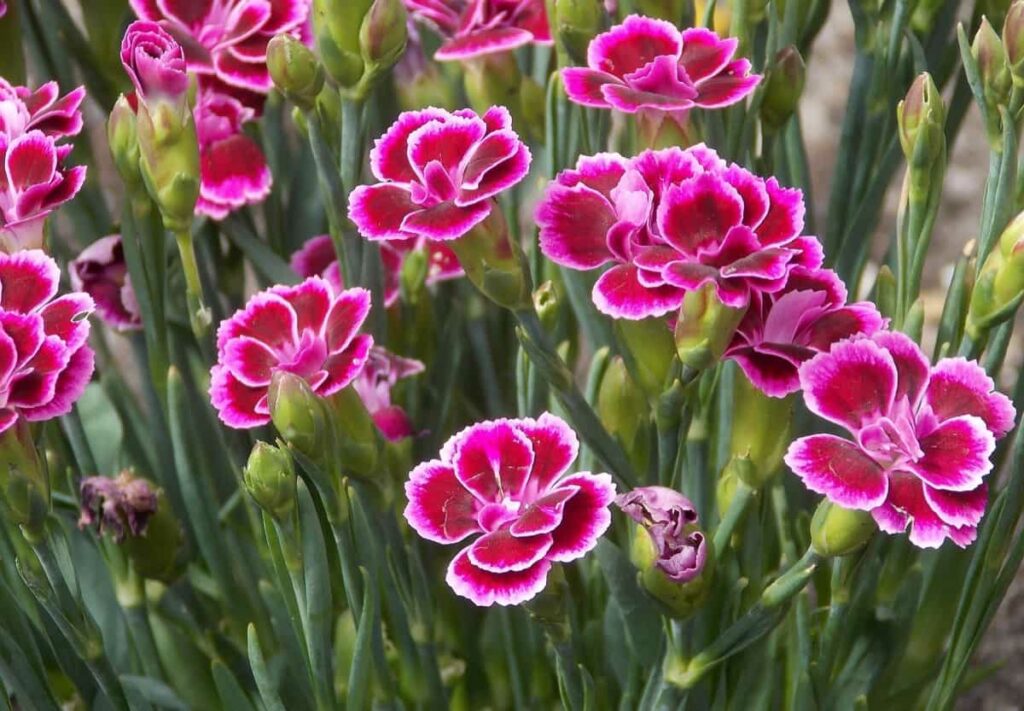
Hosts: Acorus, Belamcanda, Bergenia, Calamagrostis, Convallaria, Dianthus, Epimedium, Heuchera, Hosta, Liatris, Liriope, Luzula, Panicum, Pennisetum, Phlox, Polygonatum, Rudbeckia, Saponaria, Sedum, and Tiarella.
Damage symptoms
- Infected plants develop dark, water-soaked lesions on stems and leaves.
- During moist, warm weather, these lesions often develop pink, gelatinous masses of spores.
- This blight can result in severe plant losses if not detected early in the infection cycle.
- A beautiful harvest can be turned into rotten waste within a few days due to anthracnose.
Chemical control
- Sulfur powder and liquid copper sprays should be applied weekly, starting when foliage develops in early spring and continuing throughout the growing season. It is best to spray early in the morning and avoid applications during hot weather. Before planting seeds, they can also be treated.
- As an organic fungicide, insecticide, or miticide, neem oil spray kills eggs, larvae, and adult insects and prevents plant fungal infections. As a preventative measure, apply at the first sign of spring budding every seven to fourteen days or on a seven-day schedule until existing problems are resolved.
Damping off
It is a horticultural disease or condition that causes plants to dampen off. During the germination process, this condition weakens or damages seedlings. This disease is mainly found in wet and cool conditions and is caused by different pathogens. Several seed-borne and soil-borne fungi can cause damping-off, including Rhizoctonia solani and Aphanomyces cochlioides. This pathogen can cause significant losses to economically important flower crops by causing damping off.
In case you missed it: USA Soil pH Chart: Ideal and Optimum Range for Vegetables, Fruits, Flowers, and Herbs
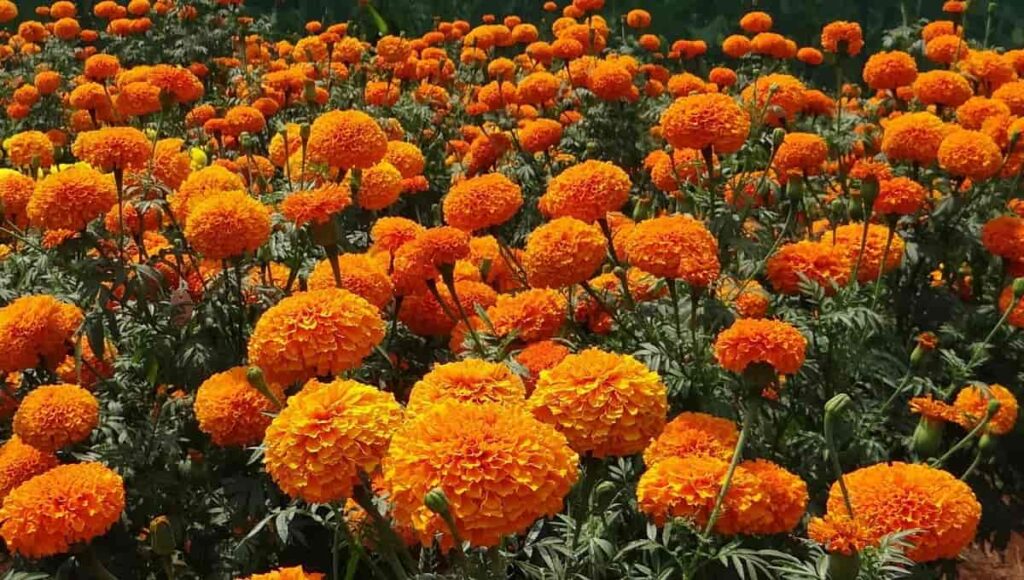
Host: Rose, Chrysanthemum, Marigold, Petunia Calendula, Cotoneaster, Flowering Quince, Hawthorn, Mountain Ash, and Spirea.
Symptoms
- Rotting seeds before germination, causing the seedlings to die before emerging, is the first symptom of damping off. This process is also regarded as Pre-emergence damping-off.
- Rotting of young seedlings around the crown region, resulting in softening of tissue, wilting, and falling over of plants, is another common symptom known as Post-emergence damping-off.
- In most cases, the seedlings turn to form a dull green color along with the drooping of cotyledons. It is mainly caused by Pythium spp., which also causes the development of water-soaked lesions on the hypocotyls at the soil line resulting in seedlings wilting and collapsing.
Chemical control and management
- Seed trays and flats should be sanitized and stored cleanly when not in use.
- Add fertilizer and lime based on soil tests to enhance the soil’s drainage, structure, aeration, and water-holding capacity.
- Heat or chemicals can be used to reduce the level of fungi that cause damping-off in the soil
- Seed treatments with metalaxyl-M can control the pre-emergence form of damping-off. Using foliar spray with captan 31.8% or metalaxyl-M 75% during cloudy weather may also help
Bacterial leaf blight
Most flower plants in all zones are affected by this disease, often referred to as black spots or leaf spots. Water is necessary for the spread and development of this fungus. During spring and summer, prolonged rainfall or damp conditions combined with warm temperatures provide the perfect breeding grounds for rose leaf blight. Standing water containing spores can infect a leaf within six hours of contact with the water.
In case you missed it: How to Control Western Flower Thrips in Chilli Crop: Identification, Fact Sheet, Chemical and Biological Management
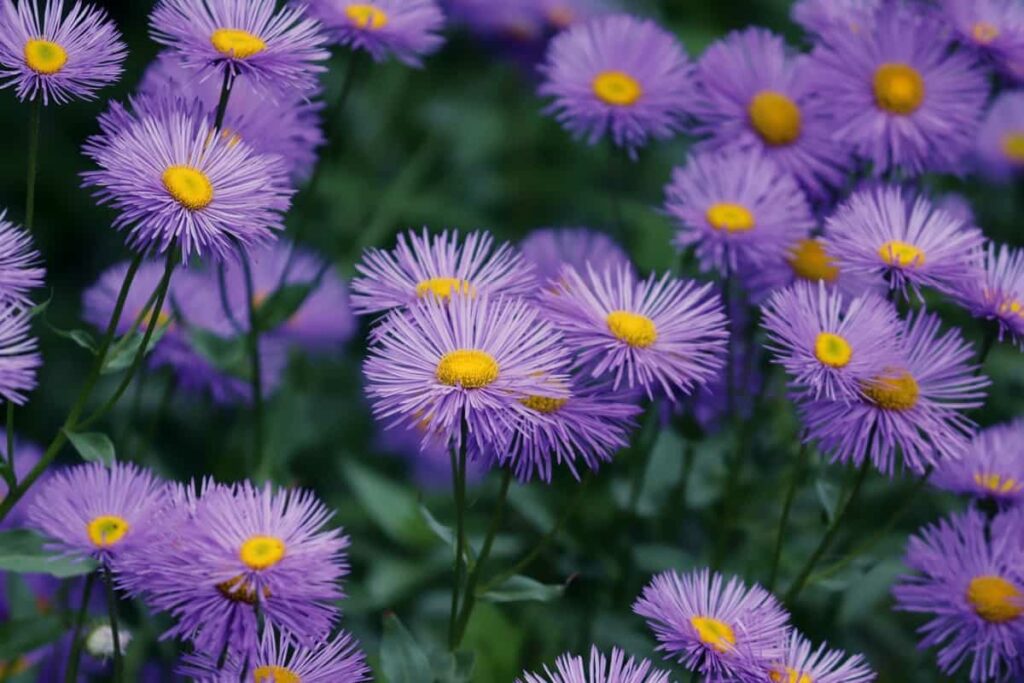
Hosts: Aster, Barberton Daisy, Begonia, Marigold, Pansy, Primrose, Snapdragon, Verbena, Zinnia, Geranium, Carnation, Chrysanthemum
Damage symptoms
- Infected leaves show small, brown, water-soaked, circular spots surrounded by a yellowish halo.
- On older plants, the leaflet infection is mostly on older leaves and may cause severe defoliation.
- Small, water-soaked spots appear, which are raised and enlarged until they are one-eighth to one-fourth inch in diameter.
- The centers of these lesions become irregular, light brown, and slightly sunken with a rough, scabby surface.
Chemical control and management
- Infected rose bushes should be treated as soon as a rose leaf spot appears to prevent the disease from spreading. The first step is to remove any diseased canes as soon as possible. After that, cut the stem two to three inches below the infected area, leaving the healthy portion.
- After each cut, sterilize the pruner blades by dipping them in 10 percent isopropyl alcohol. Remove dropped leaves by raking them up. Leaves and canes should be burned after they have been removed.
- After pruning, spray the plant with a fungicide. If applied early in the disease cycle, copper fungicides effectively control bacterial blight on flower plants.
In case you missed it: Garden Planting Calendar in India: Month-wise Chart and Guide for Fruits, Flowers, Herbs, and Vegetables
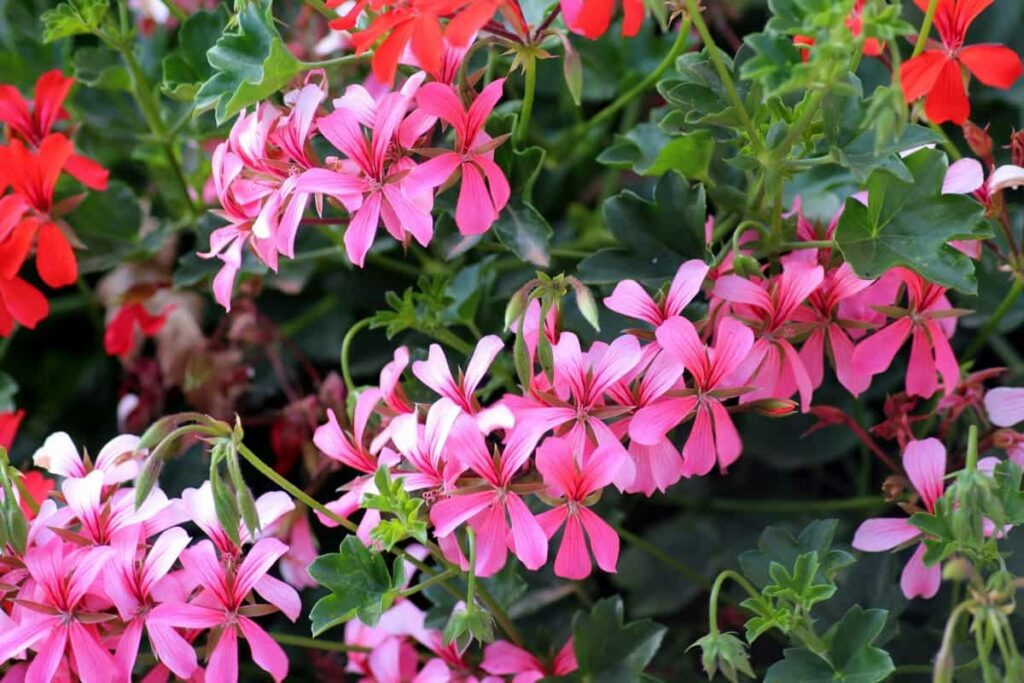
Pests in flowers
Thrips
The egg is bean-shaped, slightly narrower at one end, and almost colorless when freshly laid. The newly hatched nymph is almost white, but soon after sucking off plant sap, the color gradually changes to pale yellow. The second instar nymph is orange-yellow. The adult insect is pale yellow. The female measures 1.05 mm long and 0.19 mm wide. The male measures 0.71 mm in length and 0.14 mm in width
Host: Saffron, Chrysanthemum, Jasmine, Hibiscus, Tulips, Marigold, Rose, Lotus, Carnations, Gerberas, Geraniums, and Pansies are the major host plants.
Symptoms
- Thrips are tiny insects that feed mainly on new growing buds of the plant.
- Both nymphs and adults suck cell sap resulting in curled or bronzed leaves and deformed buds with burnt margins, and some species can also form galls on plant parts.
- Infested buds become brittle and dropdown. Some specific species may transmit plant viruses as vectors
Biological control
- Blue sticky traps are more effective, and 40-50 traps /acre are more effective.
- If black thrips attack is first observed, apply Neem oil 50000ppm-1ltr/acre, which stops eggs from hatching and larvae from growing.
- Predators: Anthocoris and Orius spp., predatory thrips, Chrysoperla carnea, Mallada sp, praying mantids, ladybird beetles, syrphid flies, spiders, etc.
- Pathogens: Steinernema sp., Verticillium lecanii, Beauveria bassiana, Metarhizium anisopliae, Paecilomyces fumerosus
Chemical control
- Insecticide Emamectin benzoate is powerful against Lepidoptera and other harmful insects, including thrips.
- Imidacloprid has a similar action to nicotine, which is a natural compound in plants such as tobacco. It is helpful in the control of thrips and other sucking insect pests
- A broad-spectrum insecticide belonging to the phenylpyrazole family, fipronil has a wide range of applications. As a white powder, it has a characteristic moldy odor. Insects such as thrips, fleas, rootworms, ticks, and termites are controlled by it.
Mites
The adult female is about 0.5 mm long, while the male is about 0.3 mm long. Females are yellowish-green, with two pronounced dark spots on the body. These spots are less conspicuous in males. Females lay up to six eggs daily, and each lays more than 70 eggs. The eggs hatch in 3 to 10 days, depending on the temperature. Young mites mature between 4 and 12 days after hatching. During summer, the total life cycle may be completed in two weeks, and overlapping generations may be seen.
Host: Rose, Hibiscus, Jasmine, Marigold, Petunia, Begonia, Chrysanthium, Lavender
In case you missed it: Seed Sowing Chart in India: Schedule Guide and Calendar for Vegetables, Flowers, Herbs, and Fruits
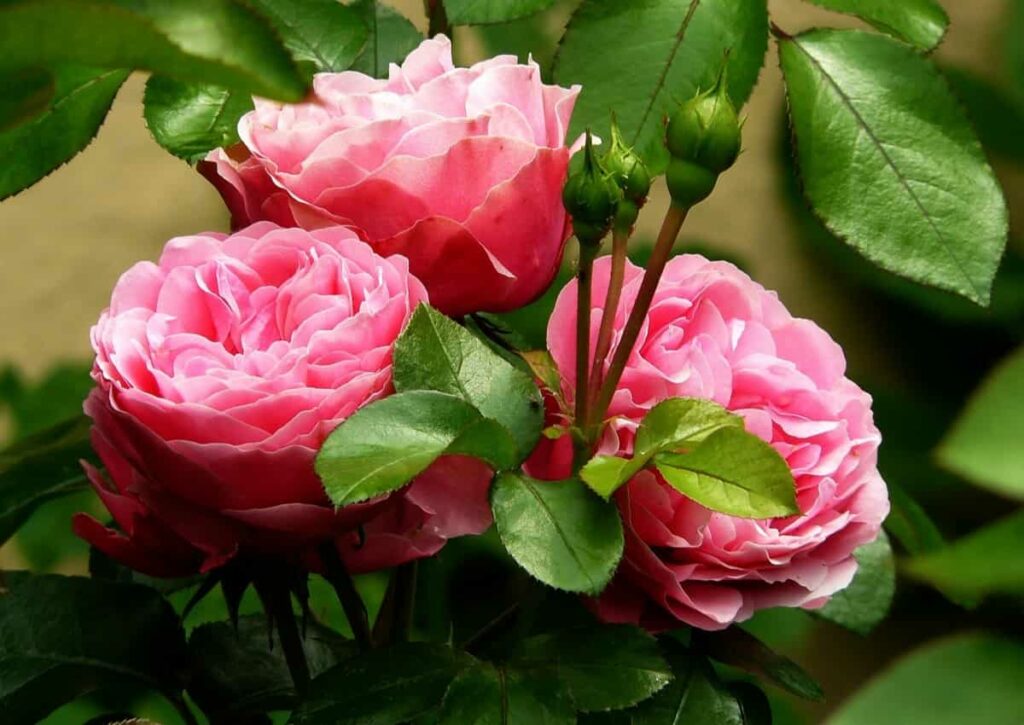
Damage symptoms
- Spider mites usually extract the cell contents from the leaves using their long, needle-like mouthparts. It results in reduced chlorophyll content in the leaves, leading to the formation of white or yellow speckles on the leaves.
- In severe infestations, leaves will completely desiccate and drop off. The mites also produce webbing on the leaf surfaces in severe conditions.
- Under high population densities, the mites use strands of silk to form a ball-like mass, which winds will blow to new leaves or plants in a process known as “ballooning.”
Biological control
- One of the best preventative methods for managing spider mite control is using and encouraging the presence of natural enemies. Most of the predators that feed upon plant-damaging mites
- Predators: Anthocorid bugs, mirid bugs, syrphid/hover flies, green lacewings, predatory mites, predatory coccinellids, staphylinid beetle predatory cecidomyiid fly, predatory gall midge, Predatory thrips, etc.
Chemical control
- Sulfur sprays can be used on flowering plants, fruit trees, and ornamentals. However, don’t use sulfur unless it is safe for that plant in your locality.
- Use liquid products such as sulfur and potash soap combinations rather than sulfur dust, which drift easily and can be breathed. Don’t use sulfur if temperatures exceed 32°C, and don’t apply sulfur within 30 days of an oil spray.
- Mix Pure Neem Oil with Coco-Wet and apply every 3-5 days to kill pest eggs and interrupt the reproductive cycle. Make sure to spray all plant parts, including the undersides of leaves.
Leaf miner
Leafminers are the larvae or immature stages of insects, small flies, sawflies, moths, or beetles that feed between the surfaces of leaves. The most common leafminers found on herbaceous plants are the larvae of small flies. Common examples are the columbine, serpentine, and pea leafminer. Mining damage may appear as blotches, serpentine, or winding trails in the leaves. This damage is because the female leafminer lays eggs in the leaf. Upon hatching, the developing larva feeds on the leaf tissue creating the mine as it goes.
Host: Lotus, Chrysanthemum, Petunia, Marigold, Rose, Jasmine, Columbines, Perennial Sunflowers, Daisies, and Veronica.
Symptoms
- As the larvae feed, pale gray lines appear on both sides of the leaf blades. In these burrows, black fecal material is visible as slim traces inside the tunnels, which are usually limited by leaf veins. As a result, damaged leaves may drop prematurely.
- Due to a reduction of photosynthetic leaf area, stunting can also be a problem in flower crops not marketed solely for their foliage.
Biological control
- Spray neem oil products (Azadirachtin) against larvae onto leaves in the early morning or late evening. For example, spray Neem oil (15000 ppm) at a rate of 5 ml/l. Make sure to have good leaf coverage. Neem slightly enters the leaves and reaches some of the larvae inside the tunnel.
- Foliar applications of the entomophagous nematode, Steinernema carpocapsae, can reduce the leafminer population.
- Other biological controls of leaf miners include parasitoids (e.g., Chrysonotomyia punctiventris and Ganaspidium hunteri) and nematodes (e.g., Steinernema carpocapsae)
Chemical control
- Broad-spectrum organophosphates, carbamates, and pyrethroids insecticides prevent adults from laying eggs but do not kill the larvae.
- Moreover, they can lead to the decrease of natural enemies and the development of resistance in the fly, which in some cases can increase their numbers.
- Products such as abamectin, chlorantraniliprole, acetamiprid, spinetoram, or spinosad can be used in a rotation to avoid the development of resistance.
Aphids
Depending on the species and plants they feed on, aphids have soft, pear-shaped bodies with long legs and antennae. The waxy white or gray substance secreted by some species gives them the appearance of being waxy or woolly. Cornicles are tube-like structures that project outward from the hind end of most species. Aphids are distinguished from all other insects by their cornicles. Adult aphids are usually wingless, but some species may develop wings, especially in spring and fall when populations are high.
Hosts: Jasmine, Saffron, Rose, Chrysanthemum, Lotus, Hibiscus, Rockcress, Heuchera, and Aubrieta
Symptoms
- Green or pink insects cluster on the flower buds, shoot tips, and young foliage
- White cast aphid skins are often seen on infested flower buds and leaves
- Flower buds and foliage can be covered in a sticky honeydew that aphids excreteBlack sooty molds may grow on the honeydew
Biological control
- Parasitic wasps that lay eggs inside aphids are among the most important natural enemies. When an aphid becomes parasitized, its skin becomes crusty and golden brown.
- Many predators also eat aphids. A few of the most well-known are lady beetle adults and larvae, lacewing, soldier beetles, and syrphid fly larvae. However, in gardens and landscapes, naturally occurring predators work best.
- Aphids can be controlled with neem oil or insecticidal soap. Make sure you follow the instructions specified.
- The spraying of cold water on the leaves will also prevent aphids from invading your crops.
- Spraying of horticultural oil will eliminate overwintering aphid eggs.
Chemical control
- Seed treatment with imidacloprid 60 FS at 10 ml/kg seed keeps the crop free from sucking pests for over a month.
- Seed treatment with thiamethoxam 70 WS at 5 g/kg seed
- Spray NSKE 5% at 2.0 ml/l OR clothianidin 50 WDG at 0.075 g/l OR imidacloprid 17.8 SL at 0.25 ml /l OR acetamiprid 20 WP at 0.2 g/l OR thiamethoxam 25 WP at 0.2 g/l
Whiteflies
Whiteflies are oval-shaped, tiny flies with mealy white wax covering their wing and yellow body. Eggs are laid on the undersurface of the leaves. The early stages of nymphs resemble scale insects, with four nymphal instars. Most whiteflies are confined to the leaf’s undersurface and continuously suck the sap from leaves. High population causes yellowing and wilting of leaves and affects plant health and flower quality.
Hosts: Hibiscus, Lavender, Jasmine, Rose, Chrysanthemum, etc.
Symptoms
- The whitefly feeds directly on the plant, causing direct damage. In addition, as a result of sucking sap, parts of the leaf become discolored.
- In addition, as they suck out the sap, they release toxic substances into the phloem, which spread throughout the plant. It causes metabolic imbalances in the plant, resulting in the overall weakening of the flowers.
- However, the most severe damage the whitefly can cause to crops is the transmission of viruses.
Biological control
- General predators include lacewings, big-eyed bugs, and minute pirate bugs.
- Several small lady beetles, including Clitostethus arcuatus, scale predators, such as Scymnus or Chilocorus species, and the Asian multicolored lady beetle, Harmonia axyridis, feed on whiteflies.
Chemical control
- Whiteflies can be challenging to control with insecticides. Most less-toxic products, such as insecticidal soaps, neem oil, or petroleum-based oils, control only those directly sprayed whiteflies. Therefore, plants must be thoroughly covered with the spray solution. Be sure to cover the undersides of all infested leaves;
- Use soaps or oils when plants are not drought-stressed and temperatures are under 32°C to prevent possible “burn” damage.
Conclusion
Combined with your watering checks, regular and frequent checks for abnormal growth and insects can be made. It is possible to wash off most of these pests with water spray. Foliage and flowering plants are rarely affected by diseases. If infected plants are moved to a drier place at the beginning of the infection, it is best to remove infected parts and avoid splashing them when watering.
- Types of Pesticides Used in Agriculture: A Beginner’s Guide
- Economical Aquaculture: A Guide to Low-Budget Fish Farming
- 15 Common Planting Errors That Can Doom Your Fruit Trees
- How to Make Houseplants Bushy: Effective Tips and Ideas
- Innovative Strategies for Boosting Coconut Pollination and Yield
- Pollination Strategies for Maximum Pumpkin Yield
- The Complete Guide to Chicken Fattening: Strategies for Maximum Growth
- Natural Solutions for Tulip Problems: 100% Effective Remedies for Leaf and Bulb-Related Issues
- Revolutionizing Citrus Preservation: Towards a Healthier, Greener Future
- Natural Solutions for Peony Leaf and Flower Problems: 100% Effective Remedies
- Maximizing Profits with Avocado Contract Farming in India: A Comprehensive Guide
- Natural Solutions for Hydrangea Problems: 100% Effective Remedies for Leaf and Flowers
- The Ultimate Guide to Choosing the Perfect Foliage Friend: Bringing Life Indoors
- From Sunlight to Sustainability: 15 Ways to Use Solar Technology in Agriculture
- The Ultimate Guide to Dong Tao Chicken: Exploring from History to Raising
- The Eco-Friendly Makeover: How to Convert Your Unused Swimming Pool into a Fish Pond
- Mastering the Art of Delaware Chicken Farming: Essentials for Healthy Backyard Flocks
- 20 Best Homemade Fertilizers for Money Plant: DIY Recipes and Application Methods
- How to Craft a Comprehensive Free-Range Chicken Farming Business Plan
- Brighten Your Flock: Raising Easter Egger Chickens for Beauty and Bounty
- How to Optimize Your Poultry Egg Farm Business Plan with These Strategies
- Subsidy for Spirulina Cultivation: How Indian Government Schemes Encouraging Spirulina Farmers
- Ultimate Guide to Raising Dominique Chickens: Breeding, Feeding, Egg-Production, and Care
- Mastering the Art of Raising Jersey Giant Chickens: Care, Feeding, and More
- Ultimate Guide to Raising Legbar Chickens: Breeding, Farming Practices, Diet, Egg-Production
- How to Raise Welsummer Chickens: A Comprehensive Guide for Beginners
- How to Protect Indoor Plants in Winter: A Comprehensive Guide
- Ultimate Guide to Grow Bag Gardening: Tips, Tricks, and Planting Ideas for Urban Gardeners
- Guide to Lotus Cultivation: How to Propagate, Plant, Grow, Care, Cost, and Profit
- Agriculture Drone Subsidy Scheme: Government Kisan Subsidy, License, and How to Apply Online
- Ultimate Guide to Raising Araucana Chickens: Breed Profile, Farming Economics, Diet, and Care
- Bringing Hydroponics to Classroom: Importance, Benefits of Learning for School Students
- Ultimate Guide to Raising Polish Chickens: Breed Profile, Farming Economics, Diet, and Care
- Ultimate Guide to Raising Australorp Chickens: Profile, Farming Economics, Egg Production, Diet, and Care
- Silkie Chicken Farming: Raising Practices, Varieties, Egg Production, Diet, and Care
- Sussex Chicken Farming: Raising Practices, Varieties, Egg Production, Diet and Care